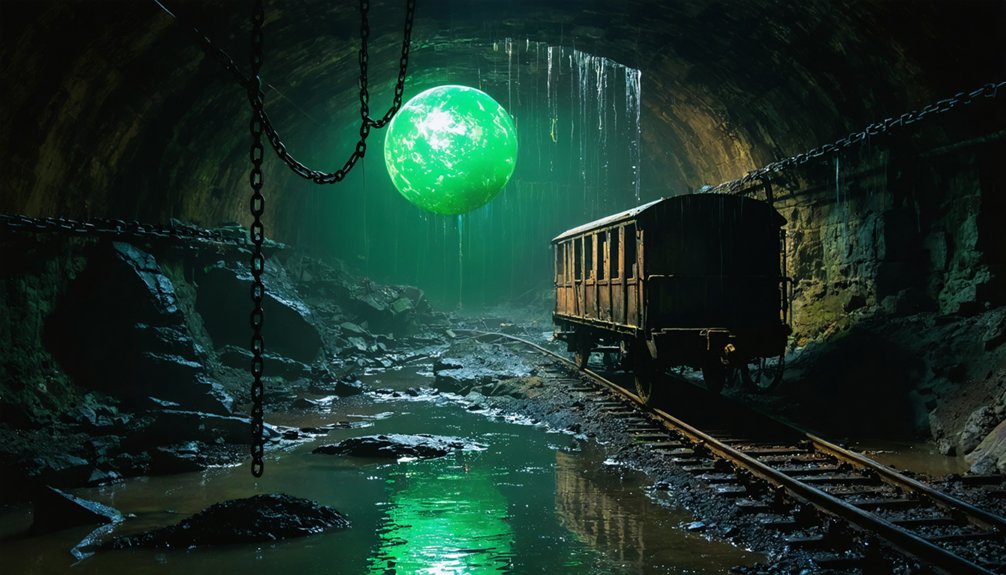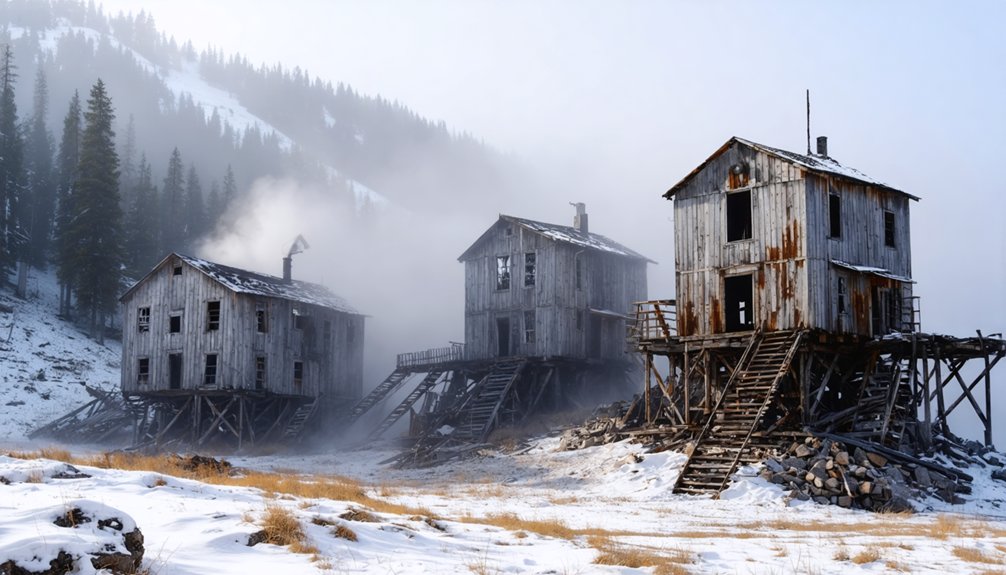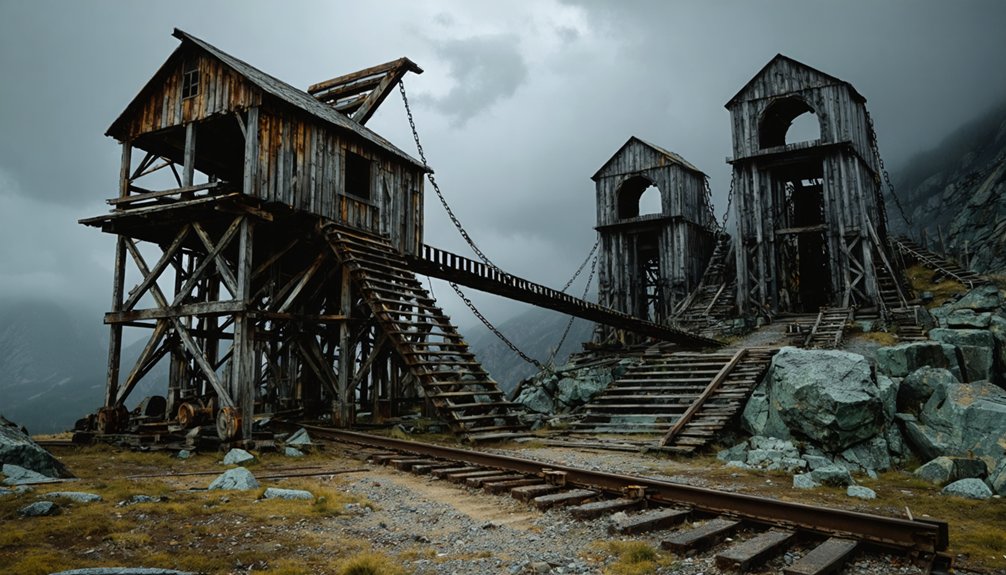Colorado’s mines offer supernatural encounters with ghostly miners who perished in accidents, translucent women searching for lost loved ones in Leadville’s historic district, and mischievous Tommyknockers who warned of impending cave-ins. You’ll find these phenomena in well-preserved ghost towns like St. Elmo and Alta, where over 1,700 miners died between the late 19th and early 20th centuries. The blood-soaked mining history has left spiritual imprints throughout these historic sites.
Key Takeaways
- Historic mining towns like Leadville feature female apparitions searching for lost loved ones near abandoned mines.
- Tommyknockers, supernatural guardians from Cornish mining folklore, are said to warn miners of impending danger.
- Ghost towns such as St. Elmo and Alta offer accessible exploration of reportedly haunted mining structures.
- The Yak Tunnel and surrounding boarding houses are hotspots for paranormal encounters with mining spirits.
- Colorado’s violent mining history created conditions for supernatural phenomena, with over 1,700 miners dying in accidents.
Ghostly Miners and Their Tragic Tales
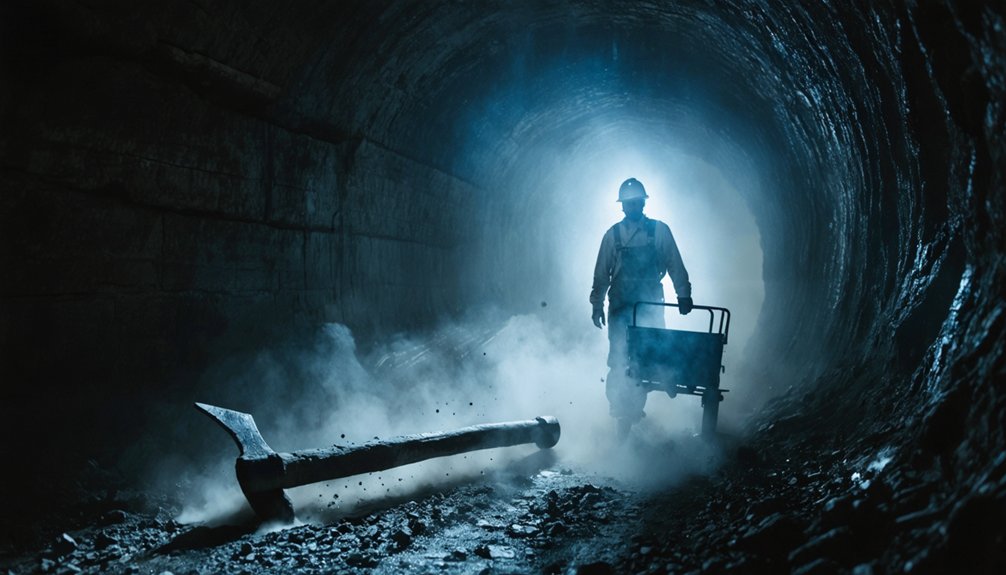
While Colorado’s mining industry once promised riches and opportunity, it simultaneously created the perfect conditions for tragedy and supernatural lore.
At elevations reaching 12,000 feet, miners endured brutal conditions that sometimes ended violently, as evidenced by the 1919 execution of four miners during an argument at Gilman.
These violent endings birthed enduring ghost stories about miners who never spiritually departed their claims.
The 1948 fire that destroyed Alta’s mine complex and Gilman’s devastating 1900 blaze ($31,000 in losses) provide backdrops for miner legends that persist today.
When you visit Alta’s boardinghouse—one of Colorado’s last major mining camp structures—you’re standing where many believe the departed still wander, unwilling to abandon the riches they sought in life. The dangers were particularly acute in the early days when miners transported valuable ore to Silverton using pack mules along treacherous mountain paths.
Visiting ghost towns like St. Elmo offers tourists a chance to explore 150 mining claims that once fueled the town’s bustling population of nearly 2,000 residents.
The Mysterious Women Haunting the Leadville Lodes
Whispers linger in the abandoned shafts of Leadville’s historic mining district, where female apparitions have become as much a part of the landscape as the weathered headframes and collapsed tunnels.
You’ll hear tales of translucent women in period dress appearing at dusk near California Gulch and Printer Boy mine, their ethereal forms silently wandering the grounds where tragedy once struck.
These spectral stories often feature women searching for lost husbands or sons who perished in cave-ins and floods during the 1870s-1890s boom.
Their spirited encounters typically occur in the Yak Tunnel and surrounding historic boarding houses.
As guardians of mining’s human cost, these apparitions contribute considerably to local folklore and tourism, embodying the resilience of mining families while offering you glimpses into Leadville’s complex social history.
The harsh living conditions in shanty towns like Poverty Flats contributed to the hardships and tragedies that many believe fuel these supernatural occurrences.
At its peak in 1882, the town had reached a 50,000 population with countless families enduring the dangers and uncertainties of mining life.
Tommyknockers: The Supernatural Guardians of the Deep

Deep within Colorado’s historic mines, you’ll encounter the enduring legend of Tommyknockers—diminutive supernatural beings standing roughly two feet tall, characterized by their white whiskers and traditional mining attire.
These creatures, central to Tommyknocker folklore, arrived with Cornish miners during the 19th-century gold rushes. You’ll hear tales of their mischievous behavior—hiding tools, extinguishing lights, and stealing bites of food. Many historians believe these legends grew more prominent as mining safety declined and workers sought supernatural explanations for the dangerous conditions.
The mysterious knockings they produced were interpreted as warnings before cave-ins, making them revered guardians of miners’ safety. Mining superstitions dictated leaving offerings, particularly the last bite of pasties. The belief that Tommyknockers were the ghosts of ancient Jewish miners was also widespread in some mining communities. Disrespecting these beings could invite misfortune.
Though rarely seen, their legacy persists in places like Idaho Springs’ Tommyknocker Brewery and the Argo Gold Mine Tour, preserving a cultural thread connecting modern visitors to Colorado’s rich mining heritage.
Blood-Soaked History: Violence in Colorado’s Mining Past
Beyond the supernatural folklore of Tommyknockers lies a darker, blood-soaked chapter in Colorado’s mining history. When you explore these historic sites, you’re walking ground where over 1,700 miners perished in accidents between the late 19th and early 20th centuries.
The infamous Ludlow Massacre of 1914 epitomizes the historical violence that plagued these mountains. During this bloody labor dispute, Colorado National Guard troops killed 21 people, including women and children hiding in underground pits.
The massacre ignited ten days of warfare across southern Colorado’s coalfields. Both sides deployed devastating tactics—miners using dynamite and rifles while company-hired detectives operated armored vehicles with machine guns. Colorado’s coal mines were notoriously dangerous with miners working 12-hour days in hazardous conditions for unfair compensation.
Companies controlled every aspect of miners’ lives, from their housing to the stores where they were forced to purchase necessities at inflated prices, creating a system of debt bondage.
This conflict, the bloodiest labor dispute in American history, ultimately contributed to vital reforms in worker safety and rights.
Exploring Haunted Mining Sites Safely Today
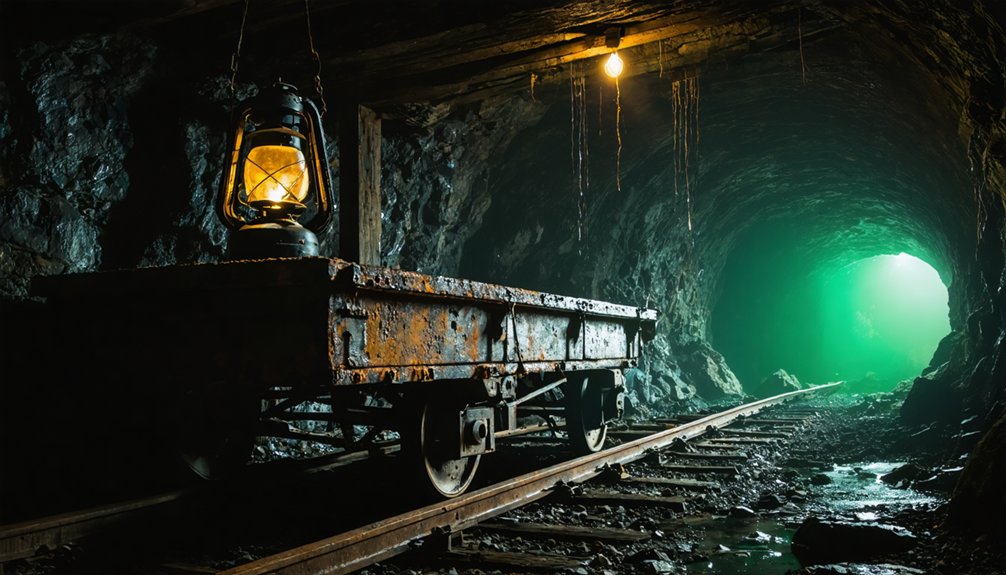
While supernatural tales and bloody history give Colorado’s mining sites their mystique, exploring these haunted locations today requires careful preparation and respect for both safety protocols and historical preservation.
You’ll find accessible ghost town exploration opportunities in well-preserved sites like St. Elmo, where wooden structures remain intact along Chalk Creek. For safe hiking, consider Vicksburg and Winfield in Clear Creek Canyon, featuring educational audio guides and poplar-lined streets planted by original prospectors.
Higher-elevation locations like Animas Forks (11,200 feet) demand four-wheel drive vehicles and alpine preparation. Alta’s National Register status protects its surviving cabins and boarding houses. Visitors can also explore Ashcroft, which became a ghost town status by 1883 after its short-lived silver boom.
For convenience, combine your expedition with nearby amenities—Mt. Princeton Hot Springs offers relaxation after investigating St. Elmo’s weathered remnants of Colorado’s silver boom.
Independence offers fascinating tours from the Aspen Historical Society where you can learn about the Independence Gold Lode and hear tales of the last settlers’ dramatic escape.
Frequently Asked Questions
Can Modern Technology Detect the Presence of Tommyknockers Underground?
No, you can’t detect Tommyknockers with technology. Ground penetrating radar and seismic imaging identify only physical phenomena, not supernatural entities. These tools measure geological features, not folklore manifestations underground.
Were Any Witchcraft Rituals Documented at Specific Mining Locations?
Like dust-covered grimoires, witchcraft history reveals you’ll find documented ritual practices primarily in Leadville’s 1899 Rothenberg case, though specific mine locations weren’t precisely recorded in the court’s official proceedings.
Have Ghost Hunters Successfully Recorded Paranormal Evidence at These Sites?
Yes, paranormal investigations have documented evidence including EVP recordings (“Get Out”), thermal anomalies, light orbs, and spirit box responses. These ghostly encounters at mining sites offer compelling artifacts for your independent analysis.
Do Hauntings Intensify During Anniversary Dates of Mining Disasters?
Like clockwork, haunting patterns intensify during disaster anniversaries. You’ll encounter more apparitions, EVPs, and EMF spikes when visiting Colorado mine sites on dates marking historical tragedies, according to documented paranormal investigations.
Are There Cultural Differences in Reported Ghost Phenomena Among Immigrant Miners?
Yes, you’ll observe distinct cultural beliefs shaped immigrant experiences: Cornish miners reported Tommyknockers, Irish miners emphasized burial omens, while German miners encountered Berggeister requiring offerings to maintain safety underground.
References
- https://www.leadvilletwinlakes.com/blog-ghosts-of-leadville-colorado/
- https://denverterrors.com/phantom-canyon-road/
- https://www.usmoneyreserve.com/resources/videos/transcripts/paranormal-activity-and-gold-did-you-know/
- https://www.altaonline.com/dispatches/a66128011/ghost-town-cloverdale-sarah-scoles/
- https://www.uchealth.org/today/ghost-towns-abound-in-colorado/
- https://www.aspire-tours.com/blogs/hidden-mines-of-colorado-forgotten-history-beneath-the-rockies
- https://www.youtube.com/shorts/WzjebVJMz-g
- https://www.historynet.com/ghost-towns-alta-colorado/
- https://www.denver7.com/news/local-news/colorado-ghost-towns-their-past-present-and-future-in-the-rocky-mountains
- https://www.visitouray.com/ghost-towns
